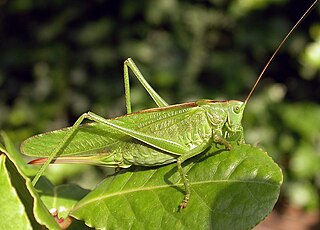
Anostostomatidae is a family of insects in the order Orthoptera, widely distributed in the southern hemisphere. It is named Mimnermidae or Henicidae in some taxonomies, and common names include king crickets in South Africa and wētā in New Zealand. Prominent members include the Parktown prawn of South Africa, and the giant wētā of New Zealand. The distribution of this family reflects a common ancestry before the fragmenting of Gondwana.

The orthopteran family Rhaphidophoridae of the suborder Ensifera has a worldwide distribution. Common names for these insects include the cave wētā, cave crickets, camelback crickets, camel crickets, spider crickets and sand treaders. Those occurring in New Zealand, Australia, and Tasmania are typically referred to as jumping or cave wētā. Most are found in forest environments or within caves, animal burrows, cellars, under stones, or in wood or similar environments. All species are flightless and nocturnal, usually with long antennae and legs. More than 1100 species of Rhaphidophoridae are described.

The family Gryllidae contains the subfamilies and genera which entomologists now term true crickets. They belong to the Orthopteran subfamily Ensifera, having long, whip-like antennae and has been reduced in terms of the older literature, with taxa such as the spider-crickets and allies, sword-tail crickets, wood or ground crickets and scaly crickets elevated to family level. The type genus is Gryllus and the first use of the family name "Gryllidae" was by Walker.

Ensifera is a suborder of insects that includes the various types of crickets and their allies including: true crickets, camel crickets, bush crickets or katydids, grigs, weta and Cooloola monsters. This and the suborder Caelifera make up the order Orthoptera. Ensifera is believed to be a more ancient group than Caelifera, with its origins in the Carboniferous period, the split having occurred at the end of the Permian period. Unlike the Caelifera, the Ensifera contain numerous members that are partially carnivorous, feeding on other insects, as well as plants.

The Tettigoniinae are a subfamily of bush crickets or katydids, which contains hundreds of species in about twelve tribes.

Tree crickets are insects of the order Orthoptera. These crickets are in the subfamily Oecanthinae of the family Gryllidae. This subfamily contains nine genera.

Gryllacrididae are a family of non-jumping insects in the suborder Ensifera occurring worldwide, known commonly as leaf-rolling crickets or raspy crickets. The family historically has been broadly defined to include what are presently several other families, such as Stenopelmatidae and Rhaphidophoridae, now considered separate. As presently defined, the family contains two subfamilies: Gryllacridinae and Hyperbaeninae. They are commonly wingless and nocturnal. In the daytime, most species rest in shelters made from folded leaves sewn with silk. Some species use silk to burrow in sand, earth or wood. Raspy crickets evolved the ability to produce silk independently from other insects, but their silk has many convergent features to silkworm silk, being made of long, repetitive proteins with an extended beta-sheet structure.

Hadenoecus is a genus of common cave cricket of the southeastern United States and typical of the tribe Hadenoecini.
Diestrammena is a 'camel' or 'cave-cricket' genus in the family Rhaphidophoridae. Species in the genus are native to Asia, including Japan.

Ceuthophilus is a genus of insects in the cave cricket family Rhaphidophoridae. It contains most of the species that are known commonly as camel crickets.

Grylloidea is the superfamily of insects, in the order Orthoptera, known as crickets. It includes the "true crickets", scaly crickets, wood crickets and other families, some only known from fossils.

Pachyrhamma waitomoensis, known as the Waitomo cave weta, is a large species of cave weta, native to the Waitomo district of New Zealand.
Ceuthophilus guttulosus, or Thomas' camel cricket, is a species of camel cricket in the family Rhaphidophoridae. It was described by Francis Walker in 1869 and is found in North America.
Euhadenoecus is a genus of camel crickets in the family Rhaphidophoridae. There are at least four described species in Euhadenoecus.
Pentacentrinae is a subfamily of crickets in the family Gryllidae. Sometimes known as 'Silent Litter Crickets', they occur in tropical Asia, Africa and the Americas.
Hadenoecus opilionides, the Tennessee cave cricket, is a species of camel cricket in the family Rhaphidophoridae. It is found in North America.

Dolichopoda is a genus of cave crickets in the tribe Dolichopodaini, subfamily Dolichopodainae. They are distributed in the Mediterranean basin in southern Europe and western Asia.
Microtachycines is a genus of cave or camel crickets in the subfamily Aemodogryllinae and tribe Aemodogryllini. The type species name M. tamdaonensis is based on specimens found in Tam Dao National Park in Vietnam.
Tamdaotettix is a genus of cave or camel crickets in the subfamily Aemodogryllinae and tribe Diestramimini. Originating in Asia, species have been found in the Indo-China region.

Wētā is the common name for a group of about 70 insect species in the families Anostostomatidae and Rhaphidophoridae, endemic to New Zealand. They are giant flightless crickets, and some are among the heaviest insects in the world. Generally nocturnal, most small species are carnivores and scavengers while the larger species are herbivorous. Wētā are preyed on by introduced mammals, and some species are now critically endangered.













